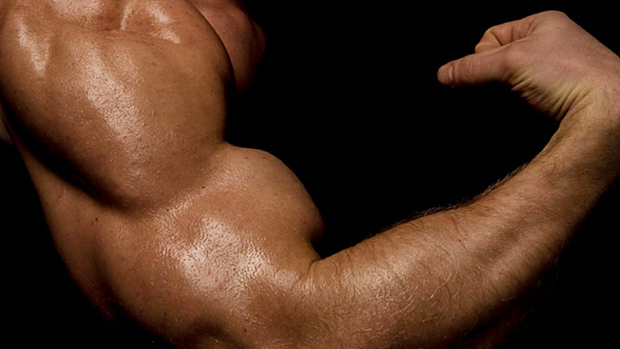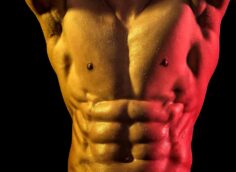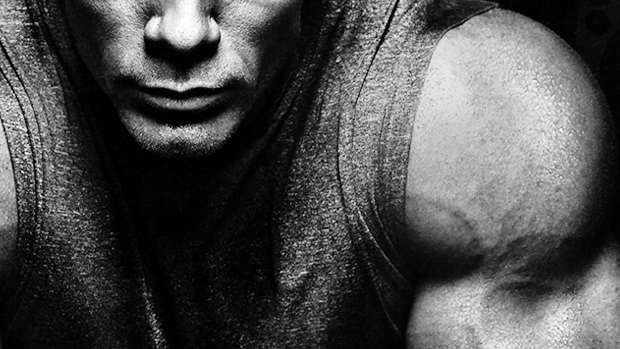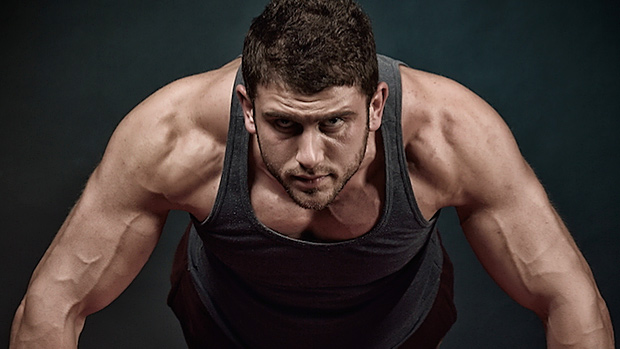Still falling for this stuff? That's okay. Most of us did at one point or another. Here's what's actually going on.
Many of us used to believe this, but science tells us something different now. It's certainly true that muscle is metabolically active tissue. When you build it, the amount of calories you burn at rest does go up. But the research shows you'll burn more like 6-10 extra calories per day for each pound of muscle you gain – significantly less than 50. (1,2,3,4)
The good news? Research shows that the more muscle mass you have, the more calories you'll burn from an intense workout (5).
You absolutely can lose fat while gaining muscle. Research has demonstrated this in variety of populations, like:
- Overweight, sedentary adult males (6)
- Older men and women (7)
- Physically active healthy men (8), and
- Young women (9)
From a nutritional perspective, although a caloric deficit is needed to lose fat, a caloric surplus isn't necessarily needed to build muscle. This is because stored fat is stored energy. So, those stored fat calories are available for the body to use as fuel for the muscle-building process.
But hold on, get this part straight: Your body can't turn fat into muscle or vice versa. Fat is fat and muscle is muscle. But, if you're overweight, your body can use your stored energy (fat) to actually fuel the muscle-building process when that fuel isn't coming from additional food intake.
The science, noted above, tells us that the more fat and the less muscle you have, the greater your ability to gain muscle and lose fat at the same time. This doesn't mean you should go get fat. It just means your biology is working in your favor when you want to pack more muscle on, but have some fat to lose.
As HIIT has grown in popularity, there's been a decline in the popularity of the standard 30-minute bout of steady-state aerobic training (the low-to-medium intensity exercise on a treadmill, elliptical, or bicycle). But if you're just starting or restarting an exercise program, beginning with HIIT may increase your odds for injury.
It's actually not a bad idea to start with low-intensity aerobic exercise until you can run or use the elliptical or bike for about 30 consecutive minutes at moderate intensity in order to increase your aerobic fitness. This gives you a better foundation for using high-intensity conditioning methods (10).
Some say steady-state cardio interferes with muscle gains. But research indicates that in previously untrained men, adding low-impact aerobic exercise (like cycling) doesn't jeopardize gains in strength or muscle size. In fact, it may even increase muscular gains (11).
Other evidence shows that aerobic exercise improves muscle size and aerobic capacity. These improvements are similar between younger and older men (12). It's likely that these results also apply to women because aerobic exercise acutely and chronically alters protein metabolism and induces skeletal muscle hypertrophy. Ironically, it can also serve as an effective countermeasure for both women and men prone to muscle loss (13).
But keep these study results in perspective because they involve untrained people. So, what impact does steady-state cardio have on trained individuals?
Well, look at what bodybuilders have been doing for years as they get closer to the stage. Bodybuilders do steady-state cardio while prepping for their shows and are able to maintain impressive amounts of muscle mass. This can't simply be chalked up to the influence of drugs because there are plenty of natural bodybuilders who do this as well.
It's unrealistic to think that doing a reasonable amount of steady-state cardio will automatically cause you to lose hard-earned muscle, especially if you're emphasizing resistance training.
For the intermediate or advanced lifter who already has a solid training base, doing high-intensity interval-style training (HIIT) each workout is unnecessary. Too much can be hard on the body. Doing too much in a given week can keep you from recovering sufficiently between workouts. A great method to use on recovery days is light to moderate cardio.

You might have heard mechanical tension, muscle damage, and metabolic stress (14) are the three mechanisms for muscle growth. However, without mechanical tension – tension exerted on the muscles from movement and external loads to reduce, produce, or control force – you don't create muscle damage or metabolic stress.
So, mechanical tension is really the driving force of muscle growth, and muscle damage and metabolic stress are just the physiological results of it. This is why lifting a lighter weight to (or near) failure produces gains in muscle size similar to that produced by lifting a heavy weight to failure (15).
In other words, mechanical tension can be created either by lifting heavy loads for fewer reps or by lifting medium loads for more reps. So, either can create a stimulus for muscle growth (16). Not to mention, regularly varying sets and reps is an effective means of improving muscle strength and size (17, 18, 19, 20).
From a practical perspective, the evidence on sets and reps tells us that there's no specific rep range for maximizing muscle size, and the smartest approach is to use both heavy-load, low-volume work with lighter-load, higher-volume work in an undulating fashion.
Wanting to look more jacked? Muscle size requires more than just the "big" compound lifts. You need to isolate certain muscles to get them to grow.
For instance, different parts of the hamstring complex can be regionally targeted through exercise selection. This falsifies the common belief that just sticking to the big lifts will give you a fully comprehensive training stimulus for building muscle.
Researchers investigated the muscle activity of the hamstrings during the leg curl, good morning, glute-ham raise, and Romanian deadlift (RDL) and found that hamstring activity was maximized in the RDL and glute-ham raise.
Another study compared hamstring exercises where movement originates at the hip versus the knee to see whether they'd cause differential activation of the hamstring muscle complex (21). The researchers found that the lying leg curl (where movement originates at the knee joint) elicited more activation of the lower lateral and lower medial hamstrings compared to the stiff-legged deadlift (where movement originates at the hip joint).
Their results were confirmed in another study, which concluded that people trying to maximize the involvement of the hams should consider focusing on both the glute-ham raise and RDL (22).
So if you think your hammies suck, maybe you're just not hitting them from all angles. Complete hamstring training should have at least one exercise where movement is focused at the hip joint, like the Romanian deadlift or its variations; and one exercise where movement is focused at the knee joint, like the leg curl, glute-ham raise or other isolation exercises.
And this goes for all muscle groups. Isolation exercises used on the same area (quads, biceps, glutes, delts) can have unique training benefits and impact muscle growth differently.
Many coaches claim that they don't use bodybuilding concepts like isolation exercises because they don't want their athletes to become overly muscle-bound and less athletic... the way they perceive many bodybuilders.
This view is out of touch with reality. Doing some hamstring curls and triceps extensions won't automatically turn you into a pro bodybuilder any more than doing sprints on a track turns you into an Olympic sprinter. Nor is the central nervous system so fragile that performing a few sets of isolation exercises or a few sets on weight machines could somehow undercut the functional abilities and movement skills acquired from long hours of sport practice and competition.
Improving your sports performance from training isn't purely related to gains in strength. They can also be related to increased bodyweight from muscle size. So, building your body actually can help you improve your overall athletic performance.
In fact, one of the things that determines our stability and strength from our feet is bodyweight. A body's mass (or weight) contributes to stability because heavier bodies are harder to move and hence are more stable. On the flipside, lighter bodies are moved more easily and are less stable (23).
So, getting bigger can help you better use your strength by providing a greater platform from which to push against your opposition. It can also give you a better chance of avoid getting knocked over or knocked off balance.
Bottom line: Getting bigger by putting on 20 pounds of muscle mass (not fat) through hypertrophy training can help you better use your strength by providing a greater platform from which to create and resist force.
- Wang, Z., Heshka, S., Zhang, K., Boozer, C.N., & Heymsfield, S.B. (2001). Resting energy expenditure: systematic organization and critique of prediction methods. Obesity Research, 9, 331-336
- Wang Z, Ying Z, Bosy-westphal A, et al. Evaluation of specific metabolic rates of major organs and tissues: comparison between men and women. Am J Hum Biol. 2011;23(3):333-8. This more recent study in 2011 study concluded one pound of muscle burns roughly 6 calories.
- Wolfe RR. (2006). The underappreciated role of muscle in health and disease. American Journal of Clinical Nutrition, 84, 475-482
- Segal KR, et al. Thermic effect of food at rest, during exercise, and after exercise in lean and obese men of similar body weight. J Clin Invest. 1985 Sep;76(3):1107-12.
- Smith, J., & McNaughton, L. (1993). The effects of intensity of exercise on excess post-exercise oxygen consumption and energy expenditure in moderately trained men and women. European Journal of Applied Physiology, 67, 420-425
- Wallace MB, et al. Effects of cross-training on markers of insulin resistance/hyperinsulinemia. Med Sci Sports Exerc. 1997 Sep;29(9):1170-5.
- Iglay HB, et al. Resistance training and dietary protein: effects on glucose tolerance and contents of skeletal muscle insulin signaling proteins in older persons. Am J Clin Nutr. 2007 Apr;85(4):1005-13.
- Dolezal BA. Et al. Concurrent resistance and endurance training influence basal metabolic rate in nondieting individuals. J Appl Physiol (1985). 1998 Aug;85(2):695-700.
- Josse AR, et al. Body composition and strength changes in women with milk and resistance exercise. Med Sci Sports Exerc. 2010 Jun;42(6):1122-30.
- Zuhl, M. and L. Kravitz. Hiit Vs. Continuous Endurance Training: Battle Of The Aerobic Titans. IDEA Fitness Journal: February 2012.
- Mikkola, J., H. Rusko, et al. 2012. Neuromuscular and cardiovascular adaptations during concurrent strength and endurance training in untrained men. Int J Sports Med. 33(9):702- 10.
- Harber,M.P.,etal.2012.Aerobic exercise training induces skeletal muscle hypertrophy and age-dependent adaptations in myofiber function in young and older men. J Appl Physiol. 113(9):1495-504.
- Konopka, A.R., M. Harber. 2014. Skeletal Muscle Hypertrophy after Aerobic Exercise Training. Exerc Sport Sci Rev. 42(2):53-61.
- Schoenfeld, B.J. 2010. The mechanisms of muscle hypertrophy and their application to resistance training. Journal of Strength and Conditioning Research 24 (10): 2857–72.
- Mitchell, C.J., et al. 2012. Resistance exercise load does not determine training-mediated hypertrophic gains in young men. Journal of Applied Physiology 113: 71–77.
- Rhea MR, Ball SD, et al. A comparison of linear and daily undulating periodized programs with equated volume and intensity for strength. J Strength Cond Res. 2002 May;16(2):250-5.
- Prestes J, Frollini AB, et al. Comparison between linear and daily undulating periodized resistance training to increase strength. J Strength Cond Res. 2009 Dec;23(9):2437-42.
- Miranda F, Simão R, et al. Effects of linear vs. daily undulatory periodized resistance training on maximal and submaximal strength gains. J Strength Cond Res. 2011 Jul;25(7):1824-30.
- Simão R, Spineti J, et al. Comparison between nonlinear and linear periodized resistance training: hypertrophic and strength effects. J Strength Cond Res. 2012 May;26(5):1389-95.
- Bartolomei S, Stout JR, et al. Block vs. Weekly Undulating Periodized Resistance Training Programs in Women. J Strength Cond Res. 2015 Oct;29(10):2679-87.
- Schoenfeld BJ, et al. Regional Differences in Muscle Activation During Hamstrings Exercise. J Strength Cond Res. 2014 Jun 24.
- McAllister MJ, et al. Muscle activation during various hamstring exercises. J Strength Cond Res. 2014 Jun;28(6):1573-80.
- William C. Whiting, and Stuart Rugg. Dynatomy: Dynamic Human Anatomy. Human Kinetics 2006. Taken from Human Kinetics website




